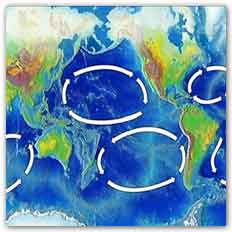|
CA new study has overturned the long held view that
microbes in the world’s oceans are highly mobile and
the same cells can be found anywhere across the
planet, unhindered by geographic boundaries.
An international team of researchers including UNSW
oceanographer, Dr Erik van Sebille, found instead
that microbes evolve faster than ocean circulation
can disperse them, leading to substantial—and
dynamic— biogeographic patterns in their surface
ocean population..

AThe study was led by Associate
Professor Ferdi Hellweger, a microbial ecologist and
environmental engineer at Northeastern University in
the US, and is published in the journal Science.
The research, which involved a
global surface ocean model, has implications for
understanding the effects of climate change on the
microbes in the ocean, which provide about half of
the oxygen we breathe.
Dr van Sebille, of the UNSW
Climate Change Research Centre, says the ocean has
at least six large catchments and this partly
explains why microbes are so different in different
parts of the ocean.
“Although all the ocean basins
are connected with each other, water doesn’t flow
easily between them. As our new study shows, this
affects microbes floating in the water. They can
easily spread within the catchment areas, but not so
much between them,” says Dr van Sebille.
Over the past several decades,
ecologists have come to understand that neutral
evolution—variation within and between species
caused by genetic drift and random mutations—plays a
role in the biogeographic patterns of ocean microbes,
along with natural selection.
"Microbes differ between ocean
provinces because of neutral evolution and dispersal
limitation. Because provinces are not well-mixed,
the differences can continue to grow,” says
Associate Professor Hellweger.
The findings shed light on how
ocean microbes may respond to global climate change.
"You may not see microbes adapt
to climate change as rapidly as if ocean microbes
were completely mixed and they were everywhere.
Certain species of microbes may not thrive under new
temperatures in certain provinces,” says Associate
Professor Hellweger.
In this study, the researchers quantified the role
of neutral evolutionary processes by simulating
division, mutation, and death of some 100,000
individual marine bacteria cells with full genomes
in a global surface ocean circulation model.
They ran the model for up to
100,000 years and then analysed the output using
advanced DNA alignment algorithms.
The team, which includes
Northeastern University doctoral student Neil
Fredrick, plans to use a similar modelling approach
to explore deep ocean microbes next, as well as the
impact of environmental selection.
For more information
Biogeographic patterns in ocean microbes emerge in a
neutral agent-based model
Ferdi L. Hellweger, Erik van Sebille, Neil D.
Fredrick.
(MDN)
|